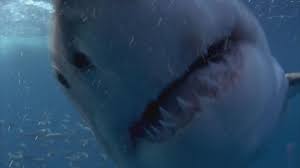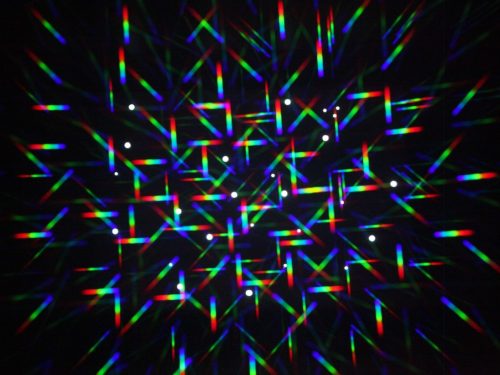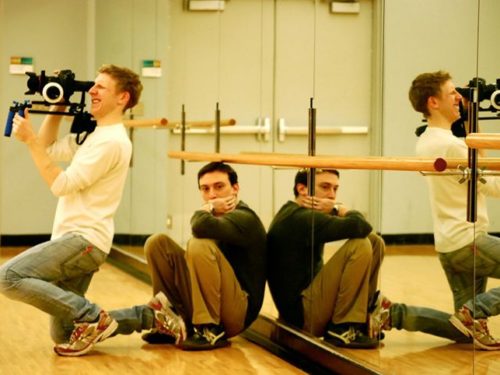Sharks are perfectly evolved underwater apex predators that capture our imaginations and take up permanent residence in the primal fascination-fear centers of our amygdala
There are three dominant species of shark movie. One is like Jaws (1975), where a region is terrorized and a rag-tag crew commences a search and destroy operation to save the community and summer — a la Great White (1981) or Red Water (2003). The second, loudest, nastiest, and most common, is the schlock, which clogs the sewers of every major and minor streaming service with no sign of abating. Turning decisively and shamelessly toward the ridiculous, this strain typically riffs on other shark movies while swallowing clichés and genres whole to create an unstoppable tide of hybrid quasi-horror-sci-fi chum: your Mega Shark vs. Giant Octopus (2009), or Toxic Shark (2017), or Santa Jaws (2018), or Shark Exorcist (2015). The third, and most formally interesting, is a stranded-at-sea narrative, where a small group of people find themselves cut off from civilization, adrift in a hostile, unforgiving, and extremely remote environment where sharks begin circling — a sub-subgenre that achieved critical mass with the breakout of Open Water (2003).
In this timeline, mainstream movie culture in the 20th century pivots on a shark movie. Jaws is considered, for better or worse, the flashpoint of modern filmmaking, the point where New Hollywood turned from a wave of mainstream experimentation toward the blockbuster era. All other underwater peril movies, off-brand aquatic antagonists, and garbage fish, and, hell, all other blockbusters, lead back to a shark movie. Sharks are the alpha and the omega, forever one of summer cinema’s favorite villains. Case in point, at the time of this writing, Ben Wheatley’s (?!) Meg 2: The Trench is a top-10 box office contender. It could have been anything that broke the industry and gamed the system; but, could it really have been? Sharks are perfectly evolved underwater apex predators, virtually unchanged from their predecessors that lived in the oceans 100 million years ago. These bastards have two additional senses, forms of electroreception that allow them to tap into the faint electrical fields all animals emit. They are basically covered in teeth from tip to tail, with rows of razor-sharp chompers and a skin of denticles that can cut if you’re unfortunate to get close enough to touch them. Sharks are and will always be in the core group of man-eaters that capture our imaginations and take up permanent residence in the primal fascination-fear centers of our amygdala.
The Reef (2010), an Australian Carcharodon movie, is firmly a category three shark story. What sets The Reef apart from the massive heap is its elegance; it’s a remarkably streamlined shark-horror machine, cutting close to the bone with its minimalism without losing sight of the provincial pleasures these movies deliver in spades. Like all survival narratives, The Reef is about circumstances conspiring to cut a small cohort off from civilization. At first, it’s enamored of the serenity and beauty of the setting, then it takes advantage of this vacation mindset, of people out of their element expecting leisure. Life-or-death choices are made and the chances of survival narrow. In keeping with tradition, The Reef is ostensibly based on a true story, that of sole-survivor Ray Boundy in 1983, but with enough details changed to avoid legal liability. The film starts off with a reunion. A vacationing couple, Matt (Gyton Stephen Grantley) and Suzie (Adrienne Pickering), are met at the airport by Luke (Damian Walshe-Howling). Luke, along with shipmate Warren (Kieran Darcy-Smith), is delivering a yacht to a customer in Indonesia and has invited Matt and Suzie to join them. Along for the trip is Matt’s sister, Kate (Zoe Naylor), who used to be in a relationship with Luke. The five of them set out on the ship for some sightseeing before setting sail for Indonesia. First, they venture to a nearby area of the coral reef for snorkeling and relaxation on a secluded beach. Here, Luke and Kate briefly rekindle the affection between them.
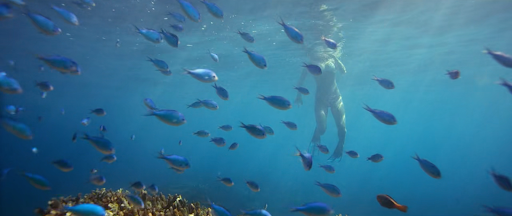
A strong current starts pulling the anchored ship toward dangerous shallows so everyone returns to the yacht and they set sail to the next stop on their planned excursion. On route, the ship suddenly strikes an outcropping of coral and capsizes. The group gathers what supplies they can from below deck, then are faced with an impossible decision: stay on the boat and hope for rescue or swim for land with none in sight. Complicating the situation, their distress beacon is all but useless, since they are not in a flight path, their food and water supply is negligible, and a strong current is pulling the ship out to open ocean and away from help. After some deliberation, four of them eventually decide to swim for the land that Luke insists is there, roughly 10-12 miles north of their position. Only Warren stays behind. The back-half of the film follows the quartet as they slowly make their way toward the horizon through shark-infested waters.
Coming up in a scene of young independent Aussie filmmakers in the late-’80s and ’90s — including a bit part in Jane Campion’s feature directorial debut, Sweetie (1989) — writer-director Andrew Traucki eventually made his mark with the crocodile swamp thriller Black Water in 2007. With his second effort, The Reef, he carved out a lane and he stuck to it, becoming something of a self-styled auteur of stripped-down survival-horror. He followed up the double shot of Black Water and The Reef with the found-footage jungle thriller The Jungle (2013), essentially the third entry in a trilogy of real-world monster movies, where a group tries to track down mythical Javan leopards in Indonesia. He also had a stopover in the anthology The ABCs of Death (2012), contributing the ocean-set, POV-obsessed vignette “G Is for Gravity.” He eventually went back to the well with sequels to his first two hits with Black Water: Abyss (2020) and The Reef: Stalked (2022). Ultimately, though, it’s The Reef that really captures his pet project at its most effective, intimate, and accomplished; his knack for a tightly coiled monster-movie collage achieves a level of refined artistry.
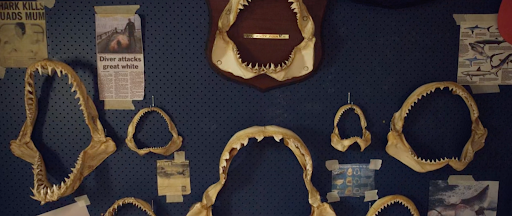
The Reef strikes a balance between its elements that feels like the platonic ideal of what shark movies set out to achieve. It is one of the most fluid executions of stitching B-roll footage of sharks in their natural habitat with actors and doubles in the water. Traucki spent nearly a week with a camera crew out in deep ocean waters filming shark footage to work into the production. The end result is remarkably restrained and deft. The footage is used sparingly, economically, and near-seamlessly. Evenly divided between the setup and the swim, its handful of segments are self-contained but interlocking. Its body count is modest, but once the survival-horror back-half kicks in, the filmmaking is deceptively precise and riveting, modulating tension as the periods between close-encounters take on an episodic rhythm toward an inevitable conclusion.
Shark movies of this particular ilk often stick to a slasher movie mindset, and The Reef is no exception; the Darwinian slasher rearing its head again. The setting is a labyrinthine death trap, narrow escapes move the plot along, and eventually the climax relies on confronting and escaping the aggressor. There are attractive vacationers, foreboding hitching posts, cryptic talismans, and points of no return. The Reef’s surreal, out-of-place interstitial of the decaying giant green sea turtle with its head chewed off — a bizarre, random jump scare in the middle of the ocean — ties the film to this lineage and makes it explicit. It’s an unexpected example of one of those slasher movie moments where an invisible barrier has been crossed and demarcates the treacherous, forbidden zone that the characters now find themselves stuck in. It also foretells their likely fate. The strange, moody evening light cues us into this shift, too. The lost are now purely subject to the whims and hunger of the beast acting on instinct in its hunting ground.
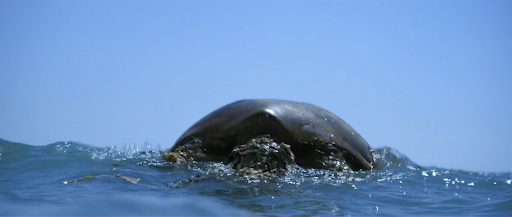
But The Reef isn’t interested in anthropomorphizing the beast or embellishing its motivation and threat. It’s steadfast in depicting the fine line between disinterest and predation that makes sharks such mysterious and fearsome creatures. The Reef marvels at a shark in its natural environment and depicts its striking intelligence and chilling methodical approach. In Jaws, and nearly everything that’s followed, the shark is a bloodthirsty killing machine on the hunt. The Reef is a taut narrative about a hungry shark but it’s full of negative space. Its man-eater is mainly curious and opportunistic, most often seen turning tail and swimming away. Like few shark movies before or since, Traucki shows the patience and discipline to capture the feeling of being cornered by a predator, of claustrophobia in a wide-open space.
The ingenious device Traucki unleashes is funneling the group’s underwater information through Luke. He’s the only one with goggles so every disturbance on the surface prompts him to dip below and report back to the other three. Sometimes he is straight with them when he returns to the surface; sometimes he minimizes, force feeding wishful thinking that the shark has moved away before it suddenly reappears. One of the beautiful aspects of ocean movies is the way they both obscure and imply the bottomless depths within any given frame. The Reef might be the most striking illustration of this compositional phenomenon. Traucki shoots the group close up, right at water level, like we’re bobbing with the characters. Often, half of the frame foregrounds the panicked faces of the victims, with the unsteady horizon line as an uncaring, disorienting constant. The bottom half is taken up by the incessant, opaque waves of the deep ocean, reflecting the clear blue sky and swallowing the unseen, vulnerable lower-halves of the four people, susceptible to anything lurking below.
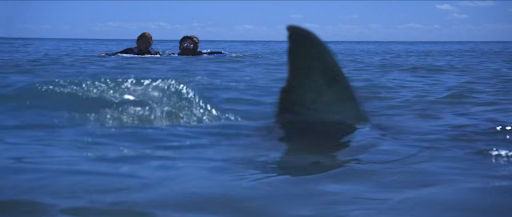
In survival narratives like this, the elemental threats that were previously implied or disregarded — exposure, hunger, dehydration, predators, etc. — become immediate and urgent. Options are narrow; irrevocable choices are made. The second half is like a photo negative of the travelogue opening stretch, the idyllic now nightmarish. The color palette of a movie set at sea is markedly different from what one expects from a horror film, filled with lush natural scenery and wildlife, vibrant colors, and sunkissed lighting. Traucki subtly shifts the shooting style as the film progresses and the situation grows more dire. With a limited range of angles and compositions, Traucki creates rhyming shots in the first and second half while expressing desperation, exhaustion, and panic. The crystalline, lyrical visuals of the opening stretch unravel and intensify. The cuts speed up and slow down in line with the heart rates of the swimmers. The seasick handheld camerawork becomes shakier and tighter. The placid underwater shots turn colder and gnarlier, breaking from the characters’ POV occasionally and deliberately to show how trapped and helpless they really are.
The white noise of the ocean, the lapping of the waves around the stranded, dominates the sound design. It’s both lulling and numbing, until it’s disturbed by a suspicious splash, screams, or panicked thrashing and churning. The masterful centerpiece shark encounter brandishes the whole toolkit, the full spectrum of Traucki’s approach. This sequence moves both methodically and swiftly, collapsing time with its patience and escalation. Alternating between the happenings above — the spiking panic and shrieks, and the dorsal fin periodically cutting through the surface of the water, and below, the shark closing in and the churn of bubbles clouding visibility — it moves from uncertainty about a sighting to Matt floating dead in the water, engulfed in a plume of blood. “My leg’s gone,” he says matter-of-factly to the others before succumbing, and the group has a moment of collective shock while still in mortal danger. We experience the shark getting closer with each pass, and the tension, release, and sudden violence in quick succession.
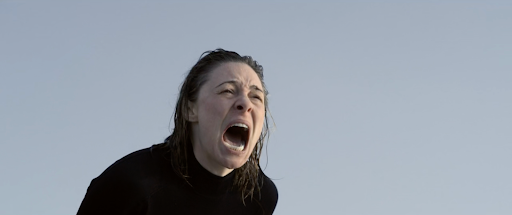
“I don’t know what’s worse: seeing them or not seeing them,” said Susan Watkins, one of the two stranded snorkelers in Open Water, talking about the shiver of tiger sharks circling. Traucki takes this off-hand, panicked statement and psychological puzzle as a challenge and a guiding principle. He savvily organizes space and directionality and achieves a tension and formal control that in its best moments feels damn-near Hitchcockian. After the harrowing set piece shark attack, and a fraught night spent in the water, the final three characters eventually wake up from a long cut to black with land in sight, craggy and not what they intended to find. The climax takes the biggest toll, as the great white picks off Suzie suddenly then stalks Luke and Kate as they desperately swim for the safety that seems to remain agonizingly out of reach. Everything converges in a sharp, inevitable point: Kate, alone on the small rock formation, helplessly screaming into the sunny open ocean. There’s a satisfying, shrewd, irreducible geometry to The Reef that brushes high art — uncertain and rarified waters to be wading in when you’re working in a subgenre built on bikinis, rubber, and buckets of fake blood. If Alexandre Aja’s awesome, gonzo Piranha 3D is “The Sistine Chapel of horror-schlock,” as Shaula Clark‘s gloriously overzealous review in the long-deceased Boston Phoenix asserted, then The Reef is the Composition II with Red, Blue and Yellow of sharksploitation.
Stream The Reef on Amazon Prime
Purchase The Reef on Blu-ray
Find the complete October Horror 2023 series here:

Stay up to date with all things Split Tooth Media and follow Oliver on Twitter
(Split Tooth may earn a commission from purchases made through affiliate links on our site.)

